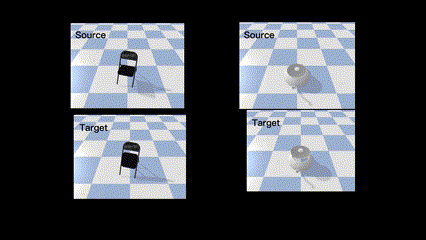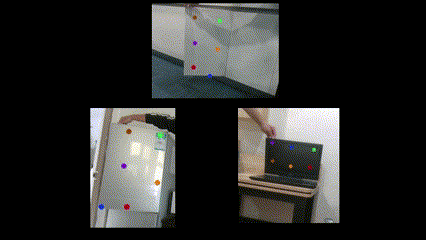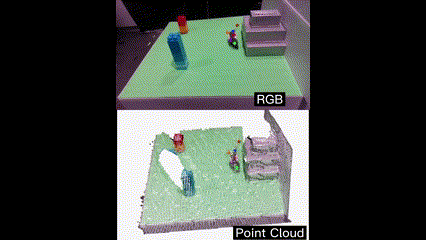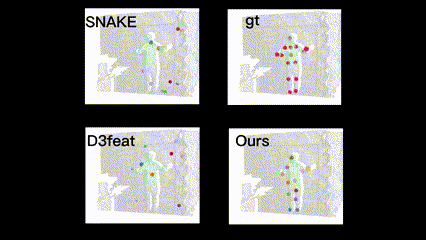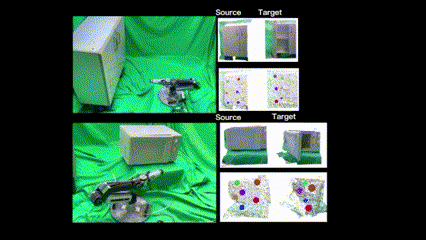This repository contains the implementation of the following paper:
3D Implicit Transporter for Temporally Consistent Keypoint Discovery
Chengliang Zhong, Yuhang Zheng, Yupeng Zheng, Hao Zhao, Li Yi, Xiaodong Mu, Ling Wang, Pengfei Li, Guyue Zhou, Chao Yang, Xinliang Zhang, Jian Zhao
In ICCV 2023 (Oral)
If you find our code or paper useful, please consider citing:
@misc{xxxxx,
author={Chengliang Zhong, Yuhang Zheng, Yupeng Zheng, Hao Zhao, Li Yi, Xiaodong Mu, Ling Wang, Pengfei Li, Guyue Zhou, Chao Yang, Xinliang Zhang, Jian Zhao},
title={3D Implicit Transporter for Temporally Consistent Keypoint Discovery},
year={2023},
booktitle={Proceedings of the IEEE/CVF International Conference on Computer Vision},
pages={xxx}
}The architecture of our model is as follows:
Discover keypoints for rigid cases (simulator and real-world):
Discover keypoints for non-rigid cases (rodents and human):
Using temporally consistent keypoints for closed-loop manipulation:
PartNet-Mobility dataset is provided by UMPNET, which can be downloaded from here.
We utilize the Pybullet simulator and object models from PartNet-Mobility dataset to generate training and test data, which can be downloaded from here. Then, move the downloaded data into 'data' folder.
Our 'data' folder structure is as follows:
data
├── bullet_multi_joint_train
│ ├── FoldingChair
│ ...
│ ├── Window
├── bullet_multi_joint_test
│ ├── Box
│ ...
│ ├── Window
Make sure that you have all dependencies in place. The simplest way to do so, is to use anaconda.
You can create an anaconda environment called 3d_transporter using
conda create --name 3d_transporter python=3.7
conda activate 3d_transporter
Note: Install python packages according to the CUDA version on your computer:
# CUDA >= 11.0
pip install -r requirements_cu11.txt
pip install torch-scatter==2.0.9
# CUDA < 11.0
pip install -r requirements_cu10.txt
pip install torch-scatter==2.0.4
Next, compile the extension modules. You can do this via
python setup.py build_ext --inplace
If a directory for storing training results does not exist, run:
mkdir exp/train0901
The name 'train0901' can be modified as per your discretion.
If train on single GPU, run:
sh exp/train0901/train_single.sh
If train on multiple GPUs, modify the values of 'CUDA_VISIBLE_DEVICES' and 'nproc_per_node' in the 'train_multi.sh' according to the number of available GPUs of yours and run:
sh exp/train0901/train_multi.sh
For seen data:
sh exp/train0901/test_seen.sh save_kpts
For unseen data:
sh exp/train0901/test_unseen.sh save_kpts
Test for seen data:
python tools/eval_repeat.py \
--dataset_root data/bullet_multi_joint_test --test_root ${scriptDir}/test_result/seen/ \
--test_type seen
Test for unseen data:
python tools/eval_repeat.py \
--dataset_root data/bullet_multi_joint_test --test_root ${scriptDir}/test_result/unseen/ \
--test_type unseen
After training, one can get 'model_best.pth' in 'exp/train0901/checkpoints'.
ln -s exp/train0901/checkpoints/model_best.pth manipulation/ckpts/
cd manipulation
sh eval.sh
We provide pretrained models on Google Drive. Move the models to exp/train0901/checkpoints/.
Our repo is released under the MIT License.
We would like to thank the open-source code of UMPNET, Transporter, Ditto, SNAKE and D3feat.


